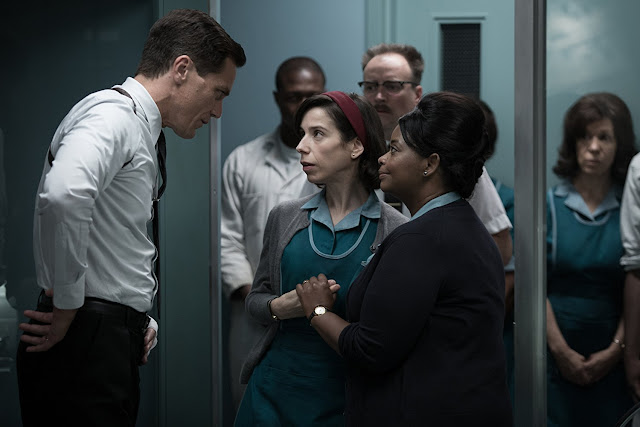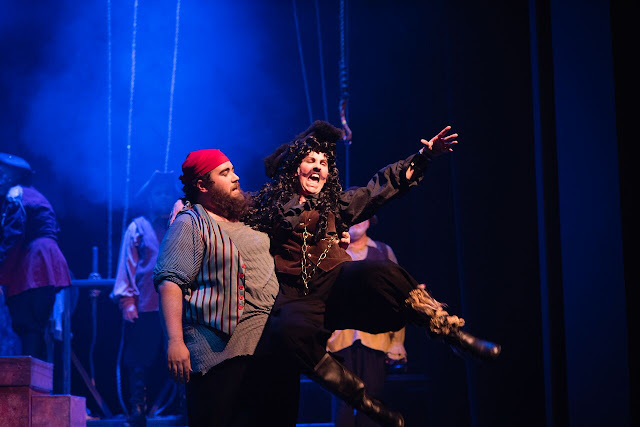From left, Glenn Kubota (Ray's Father), Eunice Bae (Cornelia), Tony Nam (Ray), and Song Kim (Uncle) in Julia Cho's Aubergine at Olney Theatre Center/Photo: Stan Barouh
Hats off to the Olney Theatre Center for joining 25 other regional theatres to present works by female playwrights, Women's Voices Theater Series, some on stages through March 14. (Olney's entry, Aubergine by Julia Cho, closes March 4.)
Tony Nam (Ray) and Eunice Bae (Cornelia) in Julia Cho's Aubergine at Olney Theatre Center/Photo: Stan Barouh
What is an aubergine?
Why, an eggplant, of course.
In this almost flawless production, Olney delivers everything you'd want on a play menu: excellent lighting (by Harold F. Burgess II), set (Misha Kachman), acting (Vincent M. Lancisi, director), staging, music (excluded from the program unless it's by the sound designer, Roc Lee), everything expected to serve an appreciative audience, except for one important ingredient.
From left, Tony Nam (Ray) and Glenn Kubota (Ray's Father) in Aubergine by Julia Cho at Olney Theatre Center/Photo: Stan Barouh
Artistic director Jason Loewith writes in the program that Ms. Cho originally wanted to make the show "light and breezy" about food (and several lines do produce loud audience laughter), but while in preparation, the "recipe" produced an unexpected result.
The eggplant and other foods are a sidebar to the meat of the drama dominated by a son, Ray (Tony Nam, recently a leading character in Olney's Our Town), who wrestles with his relationship with his father (Glenn Kubota) who lies dying, literally, on stage.
The dad's motionless body, the set centerpiece, groans and moans every so often, binding the production. He lies in exposed state, as you will, with a sickly presence which casts a pall on the surroundings. (If you have ever lived through a family illness like this, it's not something you want to repeat, unless it's to make viewers realize tempus fugit.)
In-between scene changes, in a flashback the father leaps from the bed to become an angry dad confronting his son. Although he has to maintain sleep with eyes closed most of the show, bedridden that he is, Mr. Kubota does so effortlessly, and the few lines he speaks exude strength and strong character.
While his father's health rapidly declines, Ray tries to pick up the pieces and forgive himself before the end. A woman Ray left behind, Cornelia (Eunice Bae from Olney's In the Heights and The King and I), enters to add balance and perspective.
Song Kim is an estranged uncle who arrives on scene to "forgive and forget" in a standout role. He speaks always in Korean (with subtitles on the backdrop).
The lines for the male hospice nurse, Lucien (Jefferson A. Russell, a man of much education and a former Baltimore police officer) I hope are not realistic since his insensitive manner makes one wince to see him treating family members callously at a tragic time, and gives one pause that not all hospice nurses are like Lucien. (Since Ms. Cho wrote Aubergine soon after her father's death, one surmises she observed and was a part of similar dialogues.)
Megan Anderson, also in Olney's Our Town, provides the author's introduction and is a hospital worker, too.
Electric, effective music adds mood to the production, but credit for it was not found.
Other creative crew members are: Zachary Borovay, projections; Zach Campion, dialect coach; Ivania Stack, costumes; Cat Wallis, stage manager; and Debbie Ellinghaus, managing director
What: Aubergine
Where: Olney Theatre Center, 2001 Olney-Sandy Spring Road, Olney, MD 20832
When: Now through March 4, 2018, Wednesday through Sundays at 8 p.m., weekend matinees at 2 p.m. and a 2 p.m. matinee Wednesday, February 28. If requested, a performance for the visually and hearing impaired will be performed March 1 at 8 p.m.
Tickets: Begin at $47 with discounts for groups, seniors, military, and students.
Ages: Recommended for ages 15 and up. Olney's parental guide says if this were a movie, it would be rated R due to mature themes and adult language. The play centers on impending death due to cancer and includes the impending slaughter of a turtle onstage (for turtle soup).
Duration: 2 hours and 15 minutes with one intermission
Refreshments: Available and may be taken to seats
Parking: Free, nearby, and plentiful on-site
For more information: 301-924-3400 for the box office or 301-924-4485
patricialesli@gmail.com











